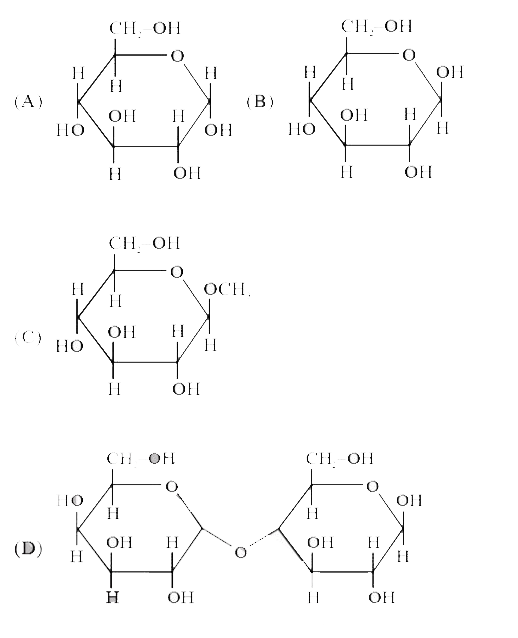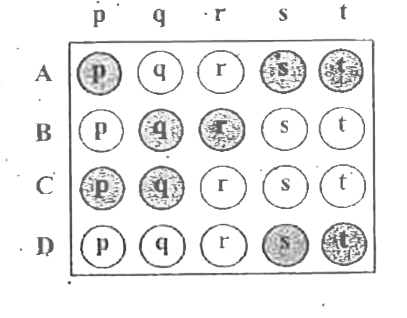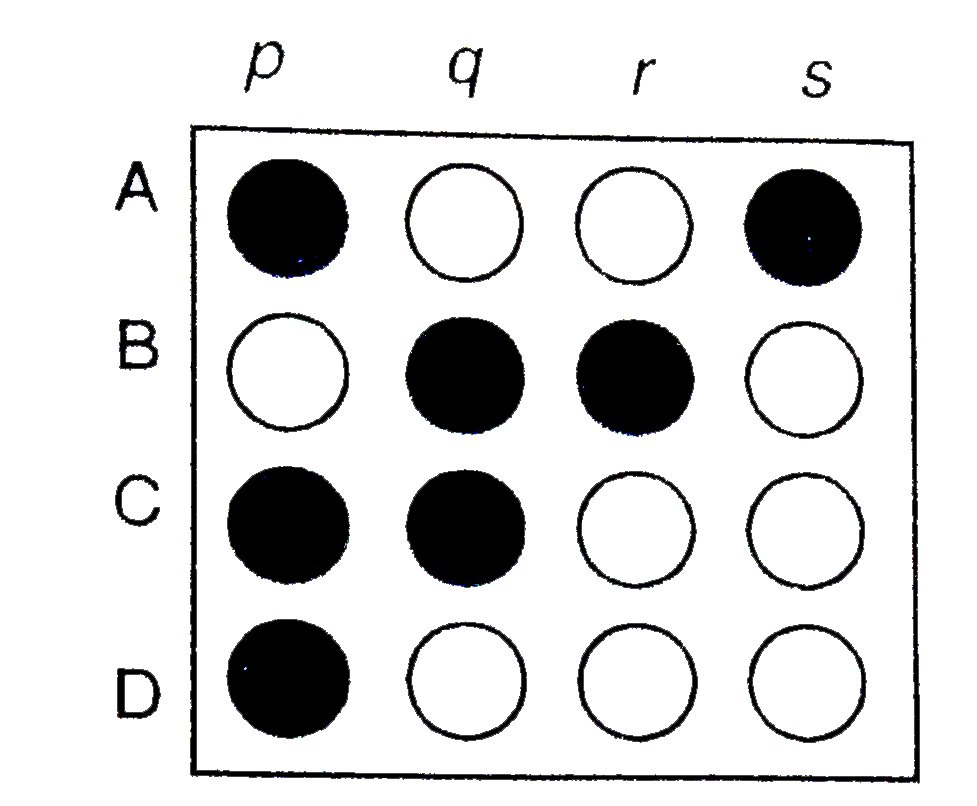Column -I Colmun -II

(P) It will undergo osazone formation
(Q) When undergo acetylation reaction with acetic anhydride molecular weight increases by 210
(R ) It is reducing sugar
(S) is known as α−D− Glucopyranose
(T) It is not reducing sugar & not show the mutarotation
A-P,Q,R,S, B-P,Q,R, C-T, D-P,R
Topper's Solved these Questions
- BIOMOLECULES & POLYMERSBOOK - MOTIONCHAPTER - BIOMOLECULES & POLYMERSEXERCISE - EXERCISE - 4 (LEVEL I)
26 Videos
- BIOMOLECULES & POLYMERSBOOK - MOTIONCHAPTER - BIOMOLECULES & POLYMERSEXERCISE - EXERCISE - 4 (LEVEL II)
17 Videos
- BIOMOLECULES & POLYMERSBOOK - MOTIONCHAPTER - BIOMOLECULES & POLYMERSEXERCISE - EXERCISE - 2 ( LEVEL - II SECTION D)
4 Videos
- ATOMIC STRUCTURE BOOK - MOTIONCHAPTER - ATOMIC STRUCTURE EXERCISE - EXERCISE-4 (LEVEL-II)
18 Videos
- CARBONL COMPOUNDSBOOK - MOTIONCHAPTER - CARBONL COMPOUNDSEXERCISE - EXERCISE - 4 LEVEL -II
24 Videos
Similar Questions
∣∣ ∣ ∣ ∣ ∣ ∣∣Column IColumn II(A)Glucose(p)Reduces Fehling solution(B)Fructose(q)Exhibits multa rotation(C)Mannose(r)Forms tetra acetyl derivative on treatmen with acetic anhydride and pyridine.(D)Glucopyranose(s)Gets oxidised byBr2/H2O∣∣ ∣ ∣ ∣ ∣ ∣∣

View SolutionThe section contains one question. Each question contains statements given in two columns which have to be matched . The statements in Column I are labelled A, B, C and D , while the statements in Column II are labelled p,q, r, s and t. Any given statement in Column I can have correct matching with ONE OR MORE statements (s) in Column II . The appropriate bubbles corresponding to the answers to these questions have to be darkened as illustrated in the following example:
If the correct matches are A-p, s and t, B-q and r, C-p and q, and D-s and t, then the correct darkening of bubbles will look like the following .

Match the following :

View Solution
Knowledge Check
P,Q, R and S are four metals whose typical reaction are given below
(I)
(II) When Q is added to a solution containing the ions of the other metals, metallic P, R, and S are formed
(III) P reacts with concentrated HNO3 but S does not
The correct order of their reducing character isAS<P<R<QBS<R<P<QCR<Q<P<SDQ<P<S<RThis section contains 2 questions. Each questions contains statements given in two columns, which have to be matched. The statements in Column I are labelled A, B, C and D, while the statements in Column II are labelled p, q, r, s and t. Any given statement in Column I can have correct matching with one or more statement(s) in Column II. The appropriate bubbles corresponding to the answers to these questions have to be darkened as illustrated in the following example :
If the correct matches are A – p, s and t, B – q and r , C – p and q, and D – s and t, then the correct darkening of bubbles will look like the following
Column II gives certain systems undergoing a process. Column I suggests changes in some of the parameters related to the system. Match the statements in Column I to the appropriate process(es) from Column II.AColumn I(P)Column II(A)The energy of the system is Increased(P)System : A capacitor initially uncharged Increased Process: It is connected to a batteryBColumn I(P)Column II(A)Mechanical energy is provided to the system, which is converted into energy of random motion of its parts (Q)System : A gas in an adiabatic container fitted with an adiabatic piston Process : The gas is compressed by pushing the pistonCColumn I(P)Column II(A)Internal energy of the system is converted into its mechanical energy.(R)System : a gas in a rigid container Process : The gas gets cooled due to colder atmosphere surrounding itDColumn IColumn II(A)Mass of the system is decreased(S)System : A heavy nucleus initially at rest Process : The nucleus fissions into two fragments of nearly equal masses and some neutrons are emitted
Column (I) Column (II)(a) GlucoseP. Reduces Tollen's reagent(b) FructoseQ. Exhibits mutarotation in mild alkaline medium(c) MannoseR. Produces tetraacetate derivative on treatment with anhydride and pyridine(d) GlucopyranosideS. Gets oxidised byBr2,H2O
View SolutionMatch the entries of column I with appropriate entries of column II. Each entry in column I may have one or more than one correct option from column II. If the correct matches are A-p, s , B-r , C-p, q , D-s, then the correctly bubbled 4×4 matrix should be as follows :
Column IColumn II(A)Rate constant of an exothermic reaction(p)increases with increase of themperature.(B)Rate constant of an endothermic reaction(q)decreases with increase of temperature.(C)Equilibrium constant of an exothermic reaction(r)not affected by adding catalyst.(D)Equilibrium constant of an endothermic reaction(s)not affected by change of initial concentration.
View SolutionMatch the column
Column IColumn II(A) acid chloride(p) Readily halogenated at αposition (B) Acid anhydride(q) Can be reduced into alcohol by LiAlH4in ether(C) Ester(r) Can be reduced into alcohol by NaBH4in ethanol(D) Acid amide(s) Can undergo catalytic hydrogenation
View SolutionMatch Column I with Column II
Column-I (Quantum numbers ) Column II ( Relation )
(A) n ( p ) Stark effect
( B ) l ( q ) Schrodinger's equation
( C ) m ( r ) Bohr's Atomic model
( D ) s ( t ) Paul's exclusivity
( t ) Auf Bau sequencing
View SolutionStatements in Column I are labelled as A, B, C and D whereas the statements in Column II are labelled as p, q, r and s. The answers to these questions are to be appropriately bubbled as illustrated below in the following example. If the correct matches are A-p, A-s, B-q, B-r, C-p, C-q and D-p, their corretly labelled 4times 4 matrix should look like :

Column-IColumn-II(A)Ionic solidsp.Dry ice(B)Molecular solidsq.Brass(C)Covalent solidsr.Generally insulators(D)Metallic solidss.Generally have low melting points
View SolutionColumn-IColumn-II(A)NH4Clin water(p)Neutral solution which does not undergo hydrolysis(B)CH3COONain water(q)Cationic hydrolysis(C)NH4CNin water(r)Anionic hydrolysis(D)NaCl in water(s)Both Cation and Anionic hydrolysis
View Solution
